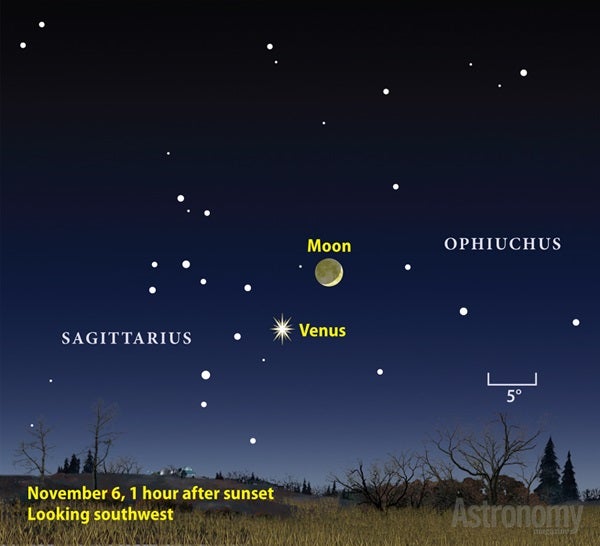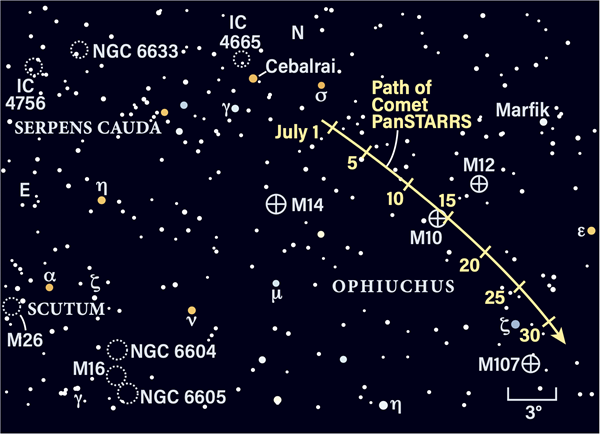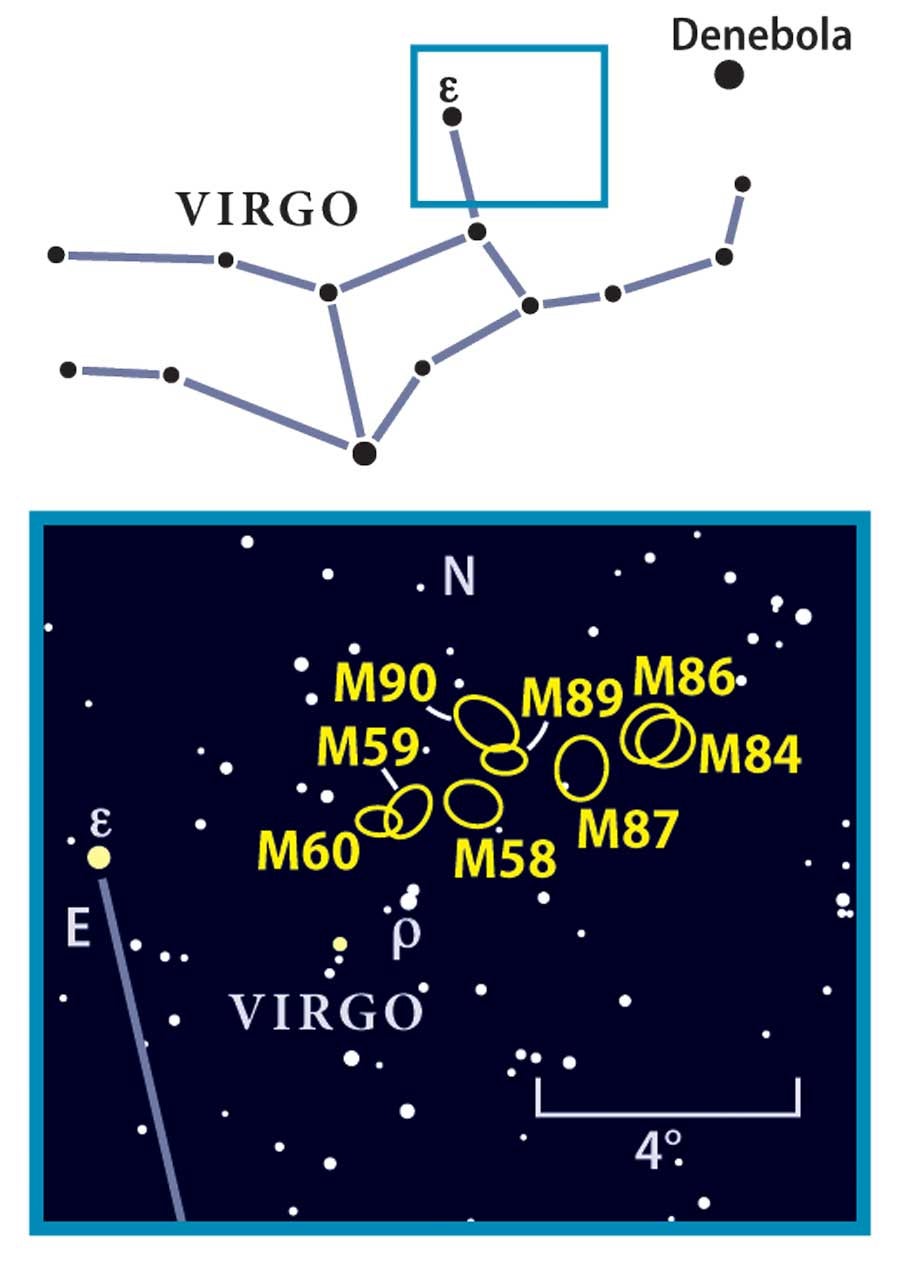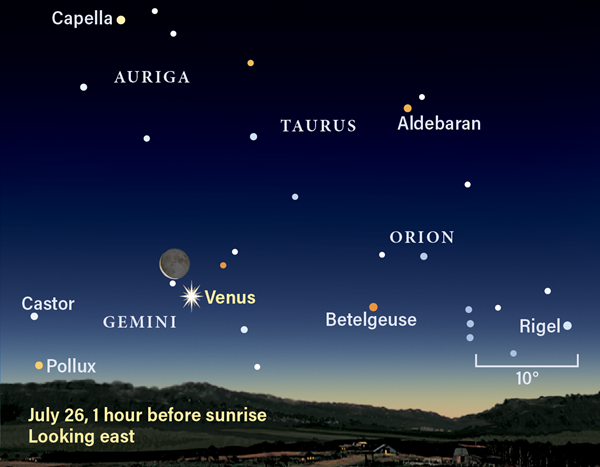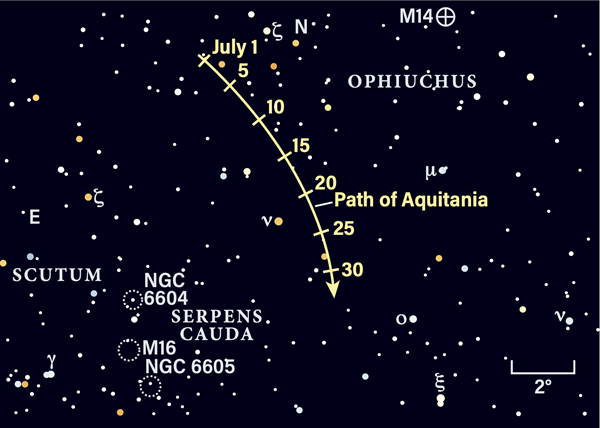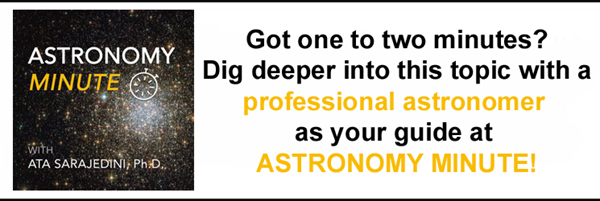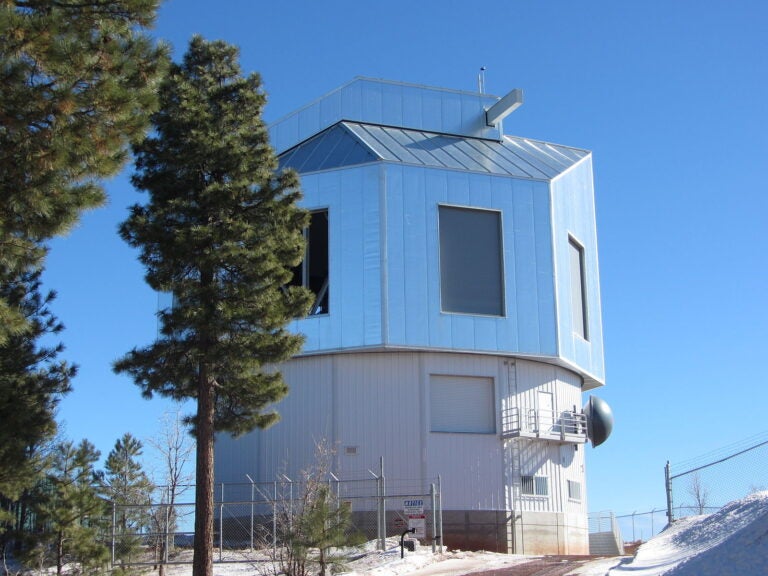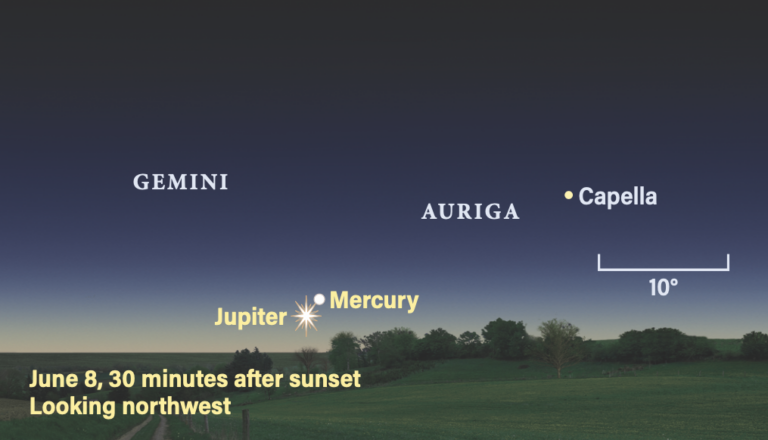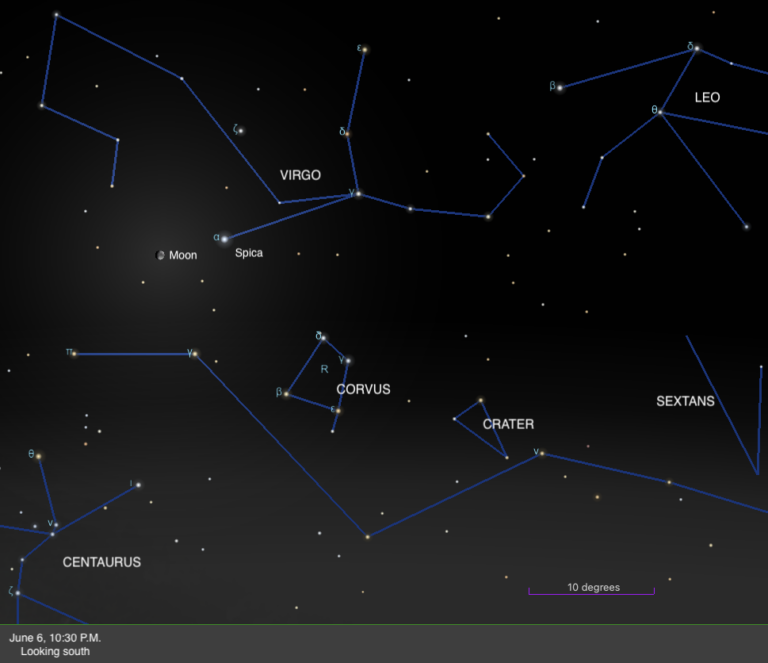Friday, July 22
The Moon passes a mere 0.2° north of Uranus at 2 A.M. EDT. Observers in parts of Africa and South America will see our satellite occult Uranus, appearing to pass in front of the planet in the sky.
To get your fill of distant solar system objects today, consider tracking down Pluto, which reached opposition a few days ago. The tiny dwarf planet is just above the southeastern horizon at sunset for most, though you’ll want to wait a while for it to climb higher in the sky — and for the sky to grow as dark as possible, as Pluto glows a faint magnitude 15. Note, too, that you’ll need a big scope for this project: we recommend 11 inches of aperture or more.
The best way to find Pluto is either using a go-to drive. If you don’t have one, you can instead star-hop using the chart we’ve provided below. To start, look for the Teapot asterism in Sagittarius — Pluto is 12.5° east-northeast of Tau (τ) Sagittarii in the Teapot’s handle. From Tau, you can jump 11° east to Terebellum. Then start moving north, where you’ll hit magnitude 7.6 SAO 188737, 3° north of Terebellum. Pluto is just 20′ northeast of this star tonight.
Sunrise: 5:50 A.M.
Sunset: 8:23 P.M.
Moonrise: 1:05 A.M.
Moonset: 3:40 P.M.
Moon Phase: Waning crescent (30%)
*Times for sunrise, sunset, moonrise, and moonset are given in local time from 40° N 90° W. The Moon’s illumination is given at 12 P.M. local time from the same location.
Saturday, July 23
At magnitude 8, Comet C/2017 K2 (PanSTARRS) is an easy comet for observers to catch with binoculars or small scopes this week. It’s currently flying through western Ophiuchus, so it’s up all evening in a rich region of the sky near the plane of the Milky Way.
You’ll find the comet floating 3.2° north of magnitude 2.5 Han (Zeta [ζ] Ophiuci) tonight. Nearby are three globular clusters you won’t want to miss, either: M10 5.4° northeast of PanSTARRS, M12 5.7° north-northeast of the comet, and M107 5.9° south of PanSTARRS’ location. Compare and contrast these star-studded fuzzballs with the comet’s dusty coma; M107, at magnitude 7.9, should be roughly the same brightness as K2. But where the clusters are generally perfect spheres, the comet should exhibit a stubby, fan-shaped tail to the north and a round bow to the south, where it faces the Sun.
Sunrise: 5:51 A.M.
Sunset: 8:22 P.M.
Moonrise: 1:34 A.M.
Moonset: 4:42 P.M.
Moon Phase: Waning crescent (21%)
Sunday, July 24
The second-largest constellation in the sky, Virgo is slowly setting in the west at sunset. It remains high enough above the horizon an hour or two after the Sun disappears for you to catch one of its greatest jewels: the Virgo Galaxy Cluster.
Some 55 million light-years away, the cluster is dominated by 9th-magnitude M87, made famous when the Event Horizon Telescope snapped a pic of its supermassive black hole. The best way to star-hop to this sight is by using magnitude 2.9 Vindemiatrix (Epsilon [ϵ] Virginis) as a jumping-off point. M87 is a little less than 8° west of this star. Alternatively, longtime Astronomy columnist Glenn Chaple prefers to look 1.5° north of magnitude 4.9 Rho (ρ) Virginis, which puts you right on two of M87’s fellow elliptical galaxies, M59 and M60, themselves 3° east of M87.
There are several other galaxies to enjoy in this area, including barred spiral M58, which sits halfway on a line between the M59/M60 pair and M87, and another elliptical galaxy pair, M84 and M86. These latter two 9th-magnitude galaxies sit about 1.3° west of M87.
There’s plenty more to see here as well — check out our finder chart above or just take your time exploring with binoculars or a small-to-medium scope. In all, the Virgo Cluster contains more than 2,000 galaxies, though the highest density of members occurs right here, around M87.
Sunrise: 5:51 A.M.
Sunset: 8:21 P.M.
Moonrise: 2:08 A.M.
Moonset: 5:42 P.M.
Moon Phase: Waning crescent (14%)
Monday, July 25
Just over a week after passing behind the Sun as seen from Earth, you may start to spot Mercury in the evening sky. You’ll want to be quick, though: 25 minutes after sunset, the tiny planet is just 2° high. To make up for that, though, it’s quite bright at magnitude –1.2. Your best bet is to find an observing location with a clear western horizon and possibly some elevation to get you above the surrounding landscape, giving you a better chance at spotting the bright planet before it sinks too low. Now in Cancer, Mercury appears 93 percent lit and is 5″ across through a telescope.
By the time darkness fully falls, turn north to see Ursa Major with her feet just above the ground. This means the Big Dipper, perhaps the most famous asterism in the northern sky, is right-side up as it swings around below the Celestial North Pole, marked by Polaris. Two famous galaxies, M81 and M82, sit some 7° north-northeast of Theta (θ) Ursae Majoris, which forms part of the Great Bear’s head. These two galaxies, which are magnitude 6.9 and 8.4, respectively, can fit within the same low-power field of view — try looking through your telescope’s finder scope to see both at once. They are not just apparently close, but also physically close on the sky, having made a close pass in the relatively recent (cosmic) past.
Sunrise: 5:52 A.M.
Sunset: 8:20 P.M.
Moonrise: 2:49 A.M.
Moonset: 6:37 P.M.
Moon Phase: Waning crescent (8%)
Tuesday, July 26
The Moon reaches apogee, the farthest point from Earth in its orbit, at 6:22 A.M. EDT. At that time, our satellite will sit 252,447 miles (406,274 kilometers) away.
You’ll find the delicate crescent Moon in the early-morning sky, just less than 4° northwest of bright Venus (magnitude –3.9) an hour before sunrise. The pair straddles the westernmost figure in Gemini, with 3rd-magnitude Epsilon Geminorum, also called Mebsuta, between them. To the east, bright Castor and Pollux, the heads of the Twins, are also rising. Blue-white Castor is highest above the horizon, while golden Pollux is lower. While it’s still early, train a telescope on Castor to split this binary in two.
Meanwhile, southeast of the Venus-Moon pairing is bright orange Betelgeuse, the shoulder of Orion the Hunter. His famous belt is also rising upward from the horizon, its three stars standing almost in a vertical line.
The Moon will pass 4° due north of Venus at 10 A.M. EDT.
Sunrise: 5:53 A.M.
Sunset: 8:19 P.M.
Moonrise: 3:36 A.M.
Moonset: 7:28 P.M.
Moon Phase: Waning crescent (4%)
Wednesday, July 27
Asteroids are numbered in order of their discovery, so it makes sense that those with the lowest numbers must be brightest and easiest to see. This month, though, is your chance to hit one of the high numbers: 387 Aquitania is now 10th magnitude, thanks to its relatively elliptical orbit, which has brought it close to Earth while our planet is near its farthest point from the Sun.
This endeavor is best with a 3- to 6-inch scope (depending on your level of local light pollution). Like Comet PanSTARRS, Aquitania is also in Ophiuchus, so it’s already high by sunset and you need only wait for the sky to darken. The nearest bright star is 3rd-magnitude Sinistra (Nu [ν] Ophiuchi); Aquitania sits 1.7° southwest of this star tonight.
Not far from where the Aquitania floats you’ll find several bonus deep-sky objects: open clusters NGC 6604, NGC 6605, and M16, all lie about 7° southeast of the main-belt asteroid’s position.
Sunrise: 5:54 A.M.
Sunset: 8:18 P.M.
Moonrise: 4:30 A.M.
Moonset: 8:11 P.M.
Moon Phase: Waning crescent (1%)
Thursday, July 28
Let’s try for one of those bright asteroids today: 3 Juno is stationary against the background stars at 6 A.M. EDT, and it’s a great early-morning target. You’ll find it highest in the hours before dawn, where it floats near the Circlet of Pisces. This asterism contains seven stars: Gamma (γ), 7, Theta, Iota (ι), 19, Lambda (λ), and Kappa (κ) Piscium. Gamma is the brightest at magnitude 3.7; this morning, Juno is just 1.8° southeast of Gamma. Juno, which spans about 145 miles (230 km), is currently magnitude 8.8. After today, it will begin moving southwest against the background stars, heading for Aquarius.
While you’re here, though, take a closer look at 19 Piscium, also known as TX Piscium. It sits 7.3° east of Gamma. This is a variable star known as a carbon star, which are some of the reddest luminaries in the heavens. Does it look rose-colored to you?
New Moon occurs this afternoon at 1:55 P.M. EDT.
Sunrise: 5:55 A.M.
Sunset: 8:17 P.M.
Moonrise: 5:29 A.M.
Moonset: 8:48 P.M.
Moon Phase: New
Friday, July 29
Jupiter reaches its stationary point in Cetus the Whale at 8 A.M. EDT. The gas giant is high in the sky before sunrise, shining brightly at magnitude –2.6. In fact, it’s not overly far from Juno, which we observed yesterday — Jupiter sits roughly 16° east of the now-familiar Circlet of Pisces.
Through a telescope, the massive planet spans 45″. All four of its Galilean moons are visible this morning: Ganymede sits to the west, while Io, Europa, and Callisto (in that order) sit to the east. After today, Jupiter will begin tracking southwest, moving from Cetus back into Pisces by the end of next month.
The solar system’s other gas giant is also on display this morning: Saturn still sits in Capricornus, some 45.5° west of Jupiter. The ringed planet is now magnitude 0.3, easily visible to the naked eye just 1.5° northwest of Deneb Algedi.
Sunrise: 5:56 A.M.
Sunset: 8:16 P.M.
Moonrise: 6:30 A.M.
Moonset: 9:19 P.M.
Moon Phase: Waxing crescent (1%)

